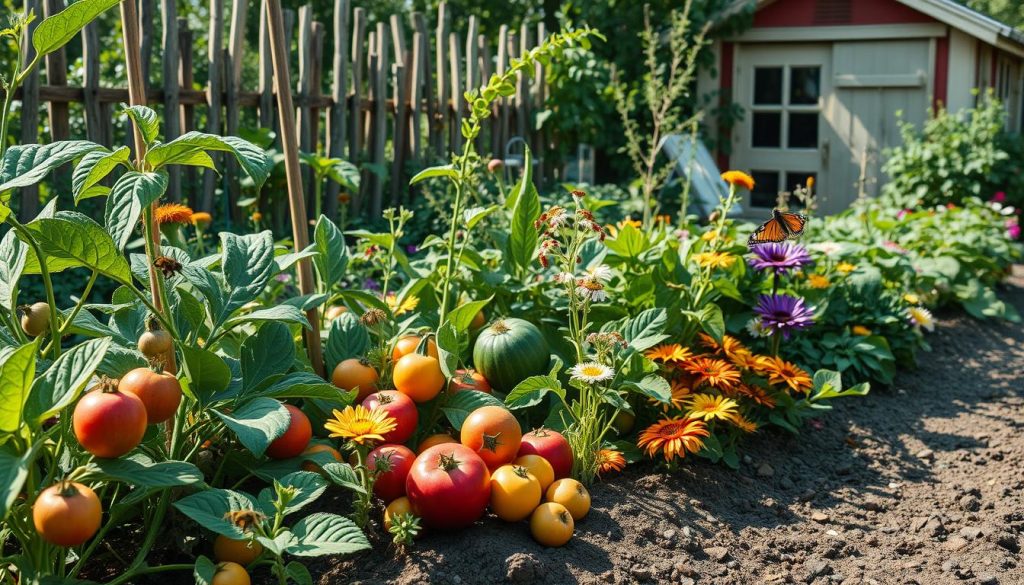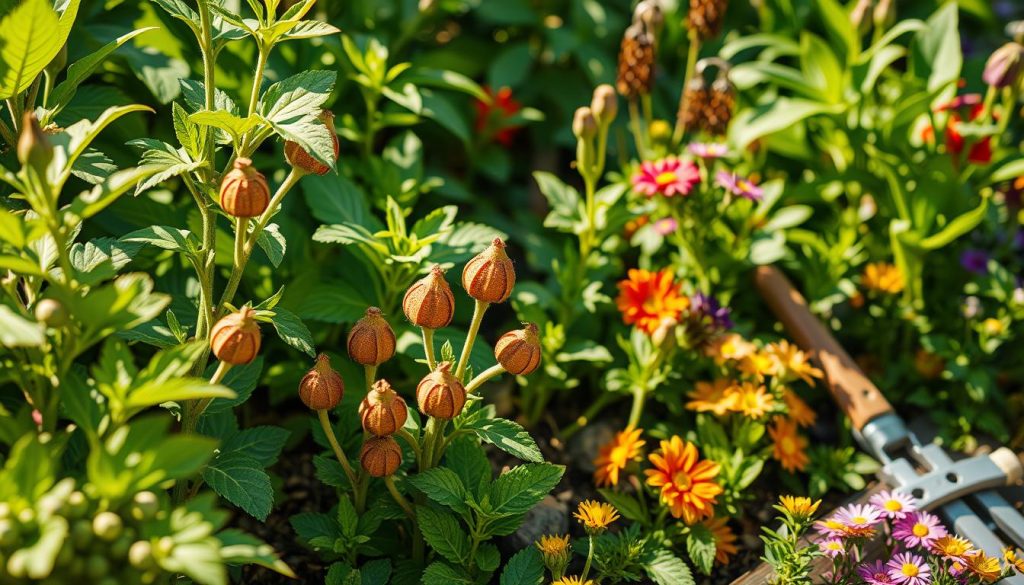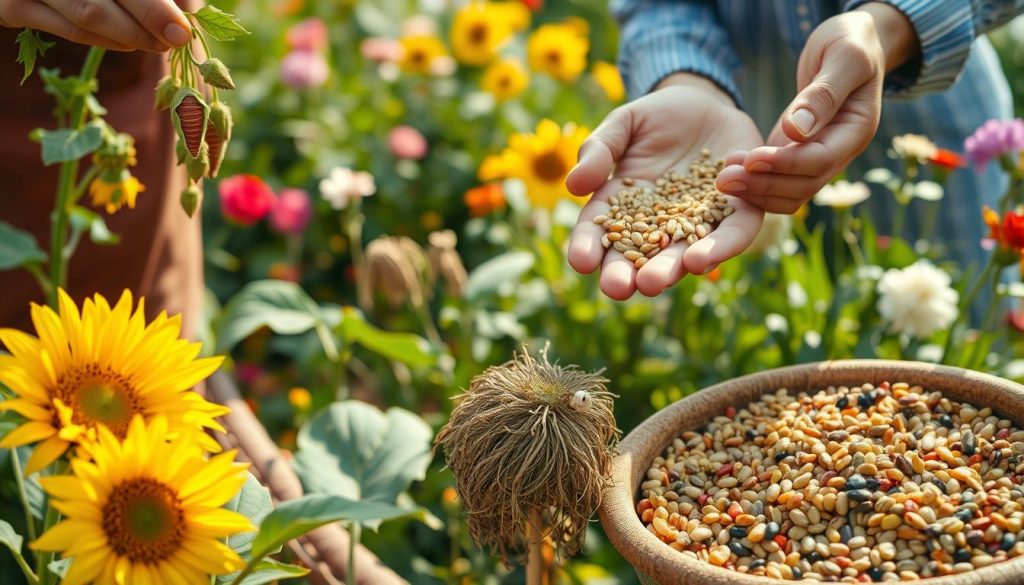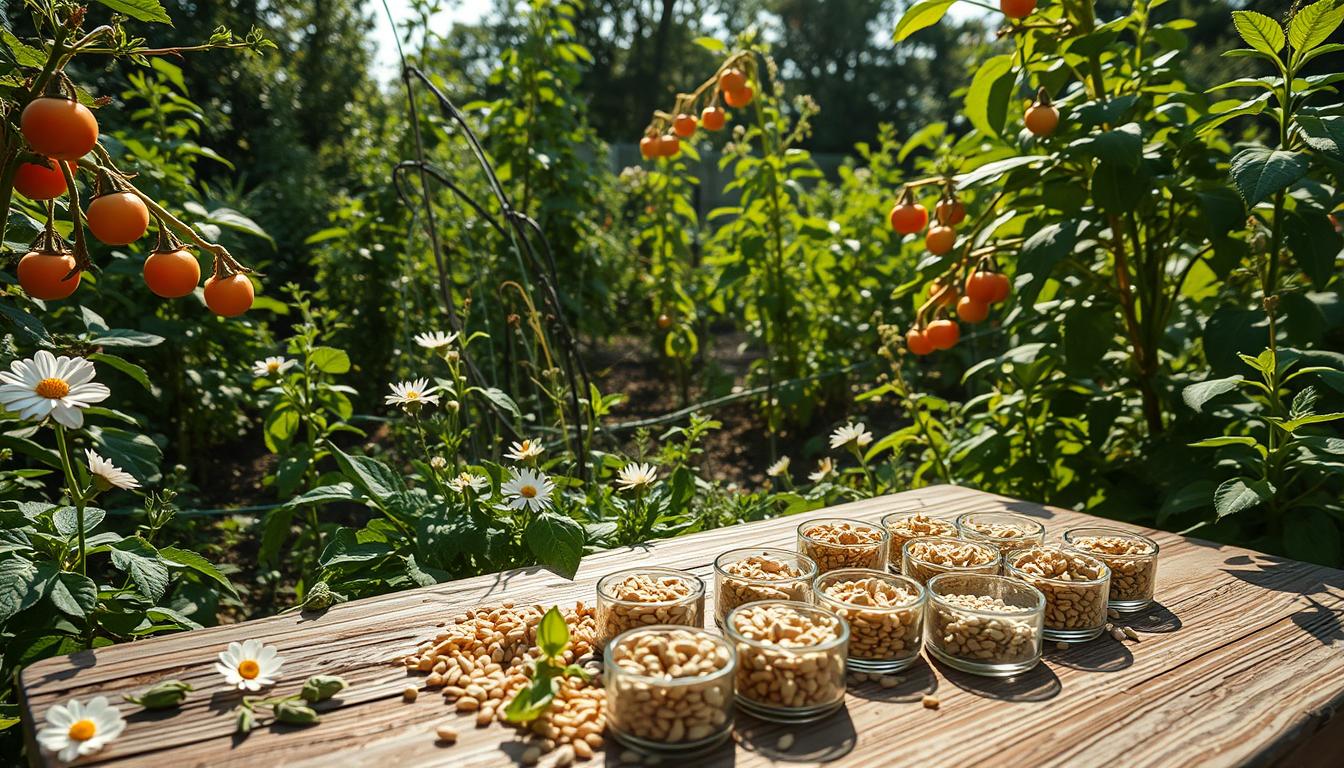I’ve always been fascinated by saving my garden’s legacy. Seed-saving is more than saving money on seeds. It’s about connecting with my plants and keeping genetic diversity alive.
Seed-saving lets me keep rare heirloom seeds alive for the future. It’s fulfilling to think I’m helping preserve plant life. By saving seeds from my best plants, I’m creating varieties that do well in my area.
In this guide, I’ll share my seed-saving journey. It has changed how I garden. I hope you’ll join me in this rewarding practice, whether you’re new to gardening or experienced.
The Importance of Seed-Saving in Modern Gardening
Seed-saving has changed the game in modern gardening. It’s more than just saving plants; it’s about growing food sustainably. Saving seeds connects me to a tradition that’s as relevant today as it was centuries ago.
Seed-saving is key to sustainable gardening. By saving seeds from top performers, I choose traits that do well in my garden. This leads to stronger, healthier plants, cutting down on the need for chemicals.
Working with open-pollinated varieties is thrilling. These plants pass on their true characteristics, helping me improve my favorite varieties. It’s like having a personal seed bank in my backyard!
Seed exchanges have opened up a new world for me. I’ve met other gardeners, swapping seeds and stories. It’s a great way to build community and protect biodiversity.
| Aspect | Benefits |
|---|---|
| Sustainability | Reduces reliance on commercial seeds, promotes self-sufficiency |
| Genetic Diversity | Preserves rare varieties, adapts plants to local conditions |
| Cost-Effective | Saves money on seed purchases, allows for larger harvests |
| Community Building | Encourages seed exchanges, fosters knowledge sharing |
Seed-saving is more than gardening; it’s about building a sustainable future. It connects me to the earth, my community, and the cycle of growth and renewal.
Understanding the Basics of Seed-Saving Practices

Seed-saving is key for gardeners who want to keep plant varieties alive. It saves money and boosts garden diversity. It’s a skill that’s easy to learn and very rewarding.
What are open-pollinated varieties?
Open-pollinated varieties grow through natural pollination. They produce seeds that grow into plants just like their parents. This makes them great for saving seeds, as they keep their traits over time.
Identifying the right plants for seed-saving
When picking plants for seed-saving, look for healthy ones. Choose plants that fit well in your area and resist pests and diseases. This ensures they’ll grow well next time.
Tools and equipment needed for seed-saving
To begin seed-saving, you’ll need some basic tools. Here’s what you’ll need:
- Clean, dry containers for storing seeds
- Labels and markers for identifying seeds
- Scissors or pruning shears for harvesting
- Fine mesh screens for cleaning seeds
- Silica gel packets to control moisture
| Tool | Purpose | Importance for Seed Viability |
|---|---|---|
| Airtight containers | Seed storage | Prevents moisture absorption |
| Silica gel packets | Moisture control | Maintains optimal seed dryness |
| Fine mesh screens | Seed cleaning | Removes debris for better storage |
Learning these basics has helped me save seeds from my favorite plants every year. It’s a fulfilling practice that boosts my organic gardening and keeps unique plant varieties alive for future seasons.
Heirloom Seeds: Preserving Genetic Diversity
I enjoy gardening with heirloom seeds. They are a treasure from the past. These seeds help keep our crops diverse.
Heirloom seeds are special because they can be saved and replanted. They have traits that help them grow well in different places.
Genetic diversity is key for farming’s future. It helps plants fight off pests and diseases. It also helps them adapt to climate changes.
By growing heirloom seeds, I’m not just growing plants. I’m helping keep our food safe for the future.
Seed libraries are important for saving these seeds. They collect, store, and share heirloom seeds. Joining a seed library is a great way to find new seeds and help save them.
- Heirloom seeds are open-pollinated and passed down through generations
- They preserve genetic diversity, crucial for resilient crops
- Seed libraries help collect and distribute heirloom varieties
Growing heirloom plants in my garden is rewarding. I get to enjoy unique tastes and colors. Plus, I’m helping keep our plant genetics rich.
It’s a simple way to connect with our farming past. It helps ensure our food systems stay diverse and sustainable.
Selecting the Best Plants for Seed Collection

In my organic gardening journey, I’ve learned that choosing the right plants for seed collection is crucial. Let’s explore how to pick the best plants, when to collect seeds, and ways to prevent cross-pollination.
Characteristics of Ideal Parent Plants
When I select plants for seed collection, I look for:
- Strong, healthy growth
- Disease resistance
- High yield
- Desirable flavor or appearance
These traits help ensure I’m preserving the best genetic material for future crops.
Perfect Timing for Seed Collection
Timing is everything in seed collection. Most seeds are ready when the fruit is fully ripe or the flower head has dried. For example, I collect tomato seeds when the fruit is overripe, and sunflower seeds when the back of the flower head turns brown.
Preventing Cross-Pollination
Cross-pollination can be a challenge in seed saving. To maintain pure seed lines, I use these techniques:
- Planting varieties far apart
- Using physical barriers like row covers
- Hand-pollinating flowers
These methods help preserve the unique traits of each plant variety in my garden.
| Plant Type | Isolation Distance | Pollination Method |
|---|---|---|
| Tomatoes | 10-50 feet | Self-pollinating |
| Corn | 1/4 mile | Wind-pollinated |
| Squash | 1/2 mile | Insect-pollinated |
Harvesting Seeds: Techniques for Different Plant Types

Seed harvesting is a rewarding practice that lets gardeners save their favorite plants. This includes open-pollinated varieties and heirloom seeds. I’ve learned that different plants need unique techniques for successful seed collection.
For fruits and vegetables, I wait until they’re fully ripe before harvesting seeds. Tomatoes and cucumbers need wet processing. I scoop out the seeds, ferment them in water for a few days, then rinse and dry them.
Peas and beans are easier – I let the pods dry on the plant, then shell them.
Flower seeds require patience. I allow the blooms to fade and seedheads to form. Once they’re dry, I carefully cut the heads and shake the seeds into a paper bag. This method works well for many open-pollinated varieties.
Here’s a quick guide for harvesting seeds from common plants:
| Plant Type | Harvesting Method | Drying Time |
|---|---|---|
| Tomatoes | Wet processing | 1-2 weeks |
| Beans | Dry on plant | 2-3 weeks |
| Marigolds | Collect dried heads | 1 week |
| Lettuce | Allow to bolt, collect seeds | 3-4 days |
Remember, timing is crucial in seed harvesting. Collect too early, and the seeds might not be viable. Wait too long, and you risk losing them to wildlife or weather. With practice, you’ll develop a keen sense for the perfect harvesting moment. This ensures a bountiful collection of seeds for your next growing season.
Cleaning and Processing Seeds for Storage
Proper seed processing is key to keeping seeds viable for storage. I’ll show you how to clean and prepare your seeds for long-term storage.
Wet vs. Dry Processing Methods
Seed processing depends on the plant type. Wet processing is for fleshy fruits like tomatoes and cucumbers. I soak these seeds in water to remove pulp.
Dry processing is best for beans, peas, and flowers. I just remove the dry seeds from their pods or heads.
Removing Chaff and Debris
Clean seeds are essential for successful storage. I use screens or sieves to separate seeds from chaff. For smaller seeds, I gently blow away debris using a fan or my breath.
This process takes patience but ensures pure seed samples.
Drying Seeds Properly
Drying is a critical step in seed processing. I spread seeds on paper towels or screens in a cool, dry area with good air circulation. It usually takes 1-2 weeks for seeds to dry completely.
Proper drying prevents mold growth and keeps seeds viable during storage.
| Seed Type | Processing Method | Drying Time |
|---|---|---|
| Tomatoes | Wet | 7-14 days |
| Beans | Dry | 5-7 days |
| Peppers | Dry | 7-10 days |
| Cucumbers | Wet | 10-14 days |
Seed Storage Solutions: Ensuring Long-Term Viability
Proper seed storage is key for keeping seeds alive in organic gardening. It helps keep genetic diversity and ensures a good garden every year.
To keep seeds fresh, I use airtight containers. Glass jars with tight lids or vacuum-sealed bags are great. I make sure seeds are dry before storing to avoid mold.
Temperature and humidity are important for seed storage. I store seeds in a cool, dark spot with low humidity. A fridge or basement is perfect. For longer storage, some use freezers, but it needs special care.
It’s important to label seeds for easy storage. I write the plant name, variety, and when I collected them on each container. This helps me keep track of seed freshness and plan for the future.
- Store seeds in airtight containers
- Keep seeds in cool, dark places
- Control humidity levels
- Label containers with relevant information
By following these steps, I’ve kept seeds viable for years. This method saves money and supports organic gardening.
Testing Seed Viability: Methods and Best Practices
Checking seed viability is crucial for a successful garden. It saves time and space by avoiding seeds that won’t grow. Let’s look at some easy ways to test seeds and understand their shelf life.
The paper towel germination test
I use the paper towel germination test often. I put a few seeds on a damp paper towel, fold it, and keep it warm. After a week, I check for sprouts. This test tells me if my seeds are good without using soil.
Understanding seed longevity for different plant species
Seed longevity varies by plant type. Tomato seeds can last up to 4 years, but onion seeds might only last a year. Knowing this helps me plan better.
When to discard old seeds
If seeds don’t sprout well, it’s time to get rid of them. I mark seed packets with the date I got them. This helps me know when to use fresh seeds. Using good seeds boosts your garden’s chances of success!
